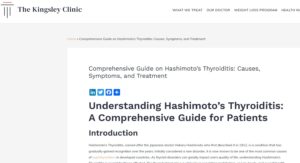The Kingsley Clinic’s Comprehensive Guide on Hashimoto’s Thyroiditis provides a clear, in-depth overview of one of the most common autoimmune thyroid disorders. Aimed at both newly diagnosed individuals and those seeking a deeper understanding, the article explains the condition’s origins, symptoms, risk factors, and current treatment options in accessible language.
Hashimoto’s thyroiditis occurs when the immune system mistakenly attacks the thyroid gland, causing inflammation and, over time, a reduction in thyroid hormone production—leading to hypothyroidism. The article begins by discussing the possible causes of the condition, which include genetic predisposition, environmental triggers, hormonal imbalances, and chronic stress.
The guide outlines a wide range of symptoms, including fatigue, weight gain, cold intolerance, depression, brain fog, dry skin, constipation, and menstrual irregularities. It emphasizes that symptoms can develop gradually and often mimic other conditions, leading to delays in diagnosis.
For diagnosis, the article explains the role of blood tests, particularly measuring TSH, Free T3, Free T4, and thyroid antibodies such as TPOAb and TgAb. It also touches on the use of ultrasound imaging to assess structural changes in the thyroid gland.
When it comes to treatment, the guide discusses the standard approach of thyroid hormone replacement therapy—typically with levothyroxine—as well as the importance of dietary support, lifestyle changes, and regular monitoring. The article also acknowledges patient interest in integrative therapies and personalized care plans.
Overall, the Kingsley Clinic’s guide offers a well-rounded, practical resource for understanding and managing Hashimoto’s thyroiditis. It encourages patients to take an active role in their care and highlights the importance of working with knowledgeable healthcare providers to ensure long-term thyroid health and quality of life.

